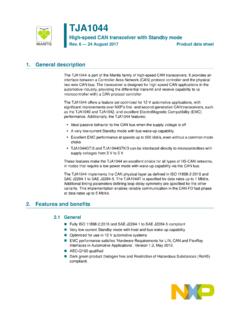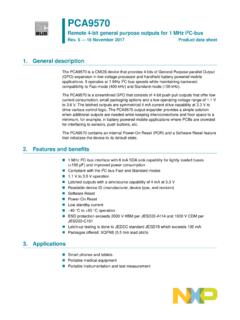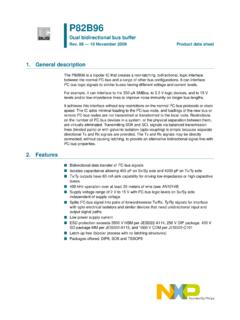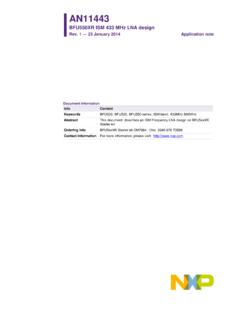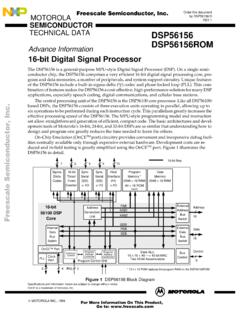Transcription of ISO 17987/LIN 2.x/SAE J2602 transceiver - NXP
1 1. General descriptionThe TJA1027 is the interface between the Local Interconnect Network (LIN) master/slave protocol controller and the physical bus in a LIN network. It is primarily intended for in-vehicle sub-networks using baud rates up to 20 kBd and is compliant with LIN , LIN , LIN , LIN , SAE J2602 and ISO 17987-4:2016 (12 V). The TJA1027 is pin-compatible with the TJA1020, TJA1021, TJA1022, TJA1029 and MC33662(B).The transmit data stream generated by the protocol controller is converted by the TJA1027 into an optimized bus signal shaped to minimize ElectroMagnetic Emissions (EME). The LIN bus output pin is pulled HIGH via an internal termination resistor.
2 For a master application, an external resistor in series with a diode should be connected between pin VBAT and pin LIN. The receiver detects a receive data stream on the LIN bus input pin and transfers it via pin RXD to the consumption is very low in Sleep mode. However, the TJA1027 can still be woken up via pins LIN and Features and General LIN 17987-4:2016 (12 V)/SAE J2602 compliant Baud rate up to 20 kBd Very low ElectroMagnetic Emissions (EME) Very low current consumption in Sleep mode with remote LIN wake-up Input levels compatible with V and 5 V devices Integrated termination resistor for LIN slave applications Passive behavior in unpowered state Operational during cranking pulse.
3 Full operation from 5 V upwards Undervoltage detection K-line compatible Available in SO8 and HVSON8 packages Leadless HVSON8 package ( mm mm) with low thermal resistance supporting Automated Optical Inspection (AOI) capability Dark green product (halogen free and Restriction of Hazardous Substances (RoHS) compliant) Pin-compatible subset of the TJA1020, TJA1021, TJA1022 and MC33662(B) Pin- and footprint-compatible with the TJA1029 TJA1027 ISO 17987/LIN J2602 transceiverRev. 3 18 December 2018 Product data sheetTJA1027 All information provided in this document is subject to legal disclaimers. NXP 2018. All rights data sheetRev. 3 18 December 2018 2 of 24 NXP SemiconductorsTJA1027 ISO 17987/LIN J2602 Protection Very high ElectoMagnetic Immunity (EMI) Very high ESD robustness: 8 kV according to IEC 61000-4-2 for pins LIN and VBAT Bus terminal and battery pin protected against transients in the automotive environment (ISO 7637) Bus terminal short-circuit proof to battery and ground Thermally protected Initial transmit data (TXD) dominant check3.
4 Quick reference data 4. Ordering information Table reference dataSymbolParameterConditionsMinTypMaxUn itVBAT battery supply voltagelimiting values +42 Voperating range5-18 VIBAT battery supply currentSleep mode; VLIN = VBAT; VSLP_N = 0 AStandby mode; VLIN = VBAT; VSLP_N = 0 ANormal mode; VLIN = VBAT; VSLP_N = 5 V; VTXD=5 V2008001600 AVLIN voltage on pin LINlimiting value with respect to GND and VBAT 42-+42 VVESD electrostatic discharge voltage on pin LIN; according to IEC 61000-4-2 8-+8kVTvjvirtual junction temperaturelimiting value 40-+150 CTable informationType numberPackageNameDescriptionVersionTJA10 27T/20SO8plastic small outline package; 8 leads; body width mmSOT96-1 TJA1027TK/20 HVSON8plastic thermal enhanced very thin small outline package; no leads; 8 terminals; body 3 3 mmSOT782-1 TJA1027 All information provided in this document is subject to legal disclaimers.
5 NXP 2018. All rights data sheetRev. 3 18 December 2018 3 of 24 NXP SemiconductorsTJA1027 ISO 17987/LIN J2602 transceiver5. Block diagram Fig diagramBUSTIMERPOWER-ON RESET &UNDERVOLTAGE DETECTIONTJA1027 VBATSLP_NTXDLINGND015aaa2122465 TEMPERATUREPROTECTIONCONTROLRXD17 TJA1027 All information provided in this document is subject to legal disclaimers. NXP 2018. All rights data sheetRev. 3 18 December 2018 4 of 24 NXP SemiconductorsTJA1027 ISO 17987/LIN J2602 transceiver6. Pinning Pinning Pin description [1]For enhanced thermal and electrical performance, solder the exposed center pad of the HVSON8 package to board TJA1027T/20: SO8 packageb.
6 TJA1027TK/20: HVSON8 packageFig configuration 1index areaTransparent top viewTable descriptionSymbolPinDescriptionRXD1recei ve data output (open-drain); active LOW after a wake-up eventSLP_N2sleep control input (active LOW); resets wake-up request on connectedTXD4transmit data inputGND5[1]groundLIN6 LIN bus line input/outputVBAT7battery connectedTJA1027 All information provided in this document is subject to legal disclaimers. NXP 2018. All rights data sheetRev. 3 18 December 2018 5 of 24 NXP SemiconductorsTJA1027 ISO 17987/LIN J2602 transceiver7. Functional descriptionThe TJA1027 is the interface between the LIN master/slave protocol controller and the physical bus in a LIN network.
7 According to the Open System Interconnect (OSI) model, this is the LIN physical LIN transceiver is optimized for, but not limited to, automotive applications with excellent ElectroMagnetic Compatibility (EMC) LIN 17987-4:2016 (12 V)/SAE J2602 compliantThe TJA1027 is fully LIN , LIN , LIN , LIN , SAE J2602 and ISO 17987-4:2016 (12 V) compliant. The LIN physical layer is independent of higher OSI model layers ( the LIN protocol). Consequently, nodes containing an ISO 17987-4:2016 (12 V) compliant physical layer can be combined, without restriction, with LIN physical layer nodes that comply with earlier revisions (LIN , LIN , LIN , LIN , LIN , LIN , LIN and LIN ).
8 Operating modesThe TJA1027 supports modes for normal operation (Normal mode) and very-low-power operation (Sleep mode). An intermediate wake-up mode between Sleep and Normal modes is also supported (Standby mode). The state diagram is shown in Figure information provided in this document is subject to legal disclaimers. NXP 2018. All rights data sheetRev. 3 18 December 2018 6 of 24 NXP SemiconductorsTJA1027 ISO 17987/LIN J2602 transceiver [1]The TJA1027 enters Sleep mode after a power-on reset ( after switching on VBAT).[2]The TJA1027 will switch automatically to Standby mode if a LIN wake-up event occurs during Sleep mode.[3]The wake-up interrupt (on pin RXD) is released after a positive edge on pin SLP_N.
9 [4]A positive edge on SLP_N will trigger a transition to Normal mode The transmitter will be off if TXD is LOW and will be enabled as soon as TXD goes HIGH.(1) A positive edge on SLP_N triggers a transition to Normal mode; the transmitter is enabled once TXD goes HIGH; in the event of thermal shut down, the transmitter is diagramTable modesModeSLP_NRXDT ransmitterDescriptionResetxfloatingoffal l inputs ignored; all outputs drivers offSleep[1]0floatingoffno wake-up request detectedStandby[2]0 LOW[3]offwake-up request detectedNormal1 HIGH: recessive state LOW: dominant stateNormal mode[4]bus signal shaping enabled015aaa215t(SLP_N = 1) > tgotonormt(SLP_N = 1) > tgotonormt(SLP_N = 0) > tgotosleept(LIN = 0 1.)
10 After LIN = 0) > twake(dom)LINfalling VBAT < Vth(POR)LNormalRXD: data outputTransmitter: on(1)StandbyRXD: lowTransmitter: offSleepRXD: floatingTransmitter: offResetRXD: floatingTransmitter: offrising VBAT > Vth(POR)HTJA1027 All information provided in this document is subject to legal disclaimers. NXP 2018. All rights data sheetRev. 3 18 December 2018 7 of 24 NXP SemiconductorsTJA1027 ISO 17987/LIN J2602 Reset modeWhen the TJA1027 is in Reset mode, it ignores all input signals and all output drivers are off. The TJA1027 switches to Reset mode when the voltage on VBAT drops below the LOW-level power-on reset threshold, Vth(POR)L. When the voltage on VBAT rises above the HIGH-level power-on reset threshold, Vth(POR)H, the TJA1027 switches to Sleep Sleep modeThe TJA1027 consumes significantly less power in Sleep mode than in any other mode.
